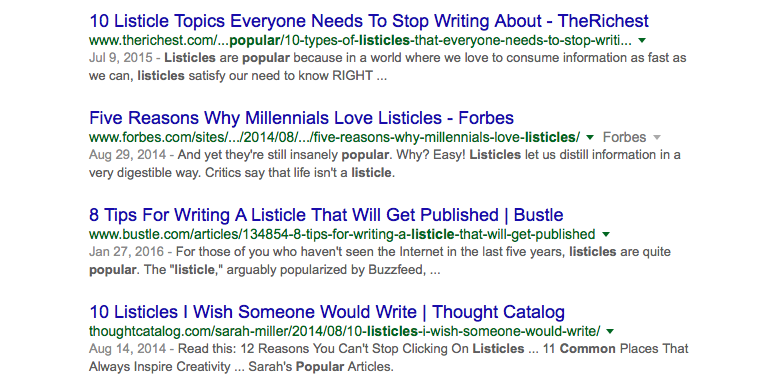Good content marketing balances what users want with what they need. So where do lists fit in?
List-formatted articles, listicles if you prefer, have been around for years. I’m not sure when they broke into the Web, but it was probably earlier than I realize. And while I wouldn’t know where to put “peak lists” on the timeline of content marketing history, I’m pretty sure that milestone has come and gone.
Even so, here we are in 2016 and list articles are still everywhere, especially in the digital marketing corner of the world. Search Google for reasons to support just about any topic, and odds are you’ll be served a handful of blogs answering your question in the form of a list.
In fact, just to show that we’ll never run out of topics, we (myself included) are now writing list articles about list articles.

There are good reasons why this format has exploded in popularity. Not coincidentally, they’re the same reasons I’ve given into the temptation to write so many of them myself.
By way of explanation—and as atonement for all the lists I’ve written over the years—here are four reasons I have a love-hate relationship with this category of content.
1. Lists are Easy
List articles are easy to write, and don’t require an outline or much planning. Likewise, users click through to these pages because they’re reliably easy to read. Posts like these endure because they require so little from parties on both sides of the content process. Lists are basically the Twinkies of content strategy: easy to produce, easy to gobble up.

2. Lists are Shallow
By their nature, lists simply name and highlight things. They’re designed to be read quickly, but some list content, particularly the intro and summary, may never be read by human eyes. As such, it’s nearly impossible to unpack a lasting and important message within the confines of a simple list. This limitation doesn’t bode well for brands that have lasting and important messages to unpack. List-oriented content is good at some things, but being thorough or profound aren’t among them.
3. Lists Don’t Build Relationships
Unless you’re a content publisher with a strategy built around lists and other easy-to-skim content (say, for entertainment), these articles probably don’t bring significant return visits. For the rest of us who market brands that do more than publish, list content is usually a one-and-done transaction. Sure, you can conclude a list with a compelling invitation for a second date, but much of your traffic is only interested in one thing: seeing the list. Strong CTAs and on-page prompts may help a little, but those invasive pop-ups can also backfire with low time-on-page and high bounce rates.
Like other content marketing, lists have the potential to be credible and useful. As of late, however, self-serving publishers have hijacked the format and turned it into a cog within their clickbait machines. (I’m looking at you, BuzzFeed.) If you’re focusing on the number of clicks your article delivers, you’re giving up content strategy for something that’s merely distracting and costly. Know what’s better than a click? A new lead who wants to learn more.
4. Lists Don’t Establish Authority
The nice thing about list-based articles is that almost anyone in your office can write one. Unfortunately this is also a weakness of the listicle. Since it’s such an easy space to get into, everyone shows up whether they’re qualified to be there or not. Long-form articles, on the other hand, are harder to write, and less forgiving toward posers. Without the framework of a simple list, authors have to rely heavily on their experience, technical know-how, and writing skills. These are the hallmarks of authority.
Where’s the love for lists?
None of this, though, has convinced me the listicle is dead—and I don’t think it’s ready to be killed. These articles still have a role to play in user-focused content strategy. But they need to be balanced with other content that challenges readers, explores deeper concepts, builds relationships, and positions the brand as an authority.
When was the last time you shined a light on your own content strategy? If you see a high concentration of lists and other “easy” content, it might be time to shift your efforts toward things like:
- A customer’s path to success written as an engaging story
- A technical article that digs deep into a single, laser-focused topic
- A researched comparison of two industry methods, products, philosophies, etc.
In the end, it’s not about word count. Good content marketing balances what users want with what they need. That’s a good place to start.
